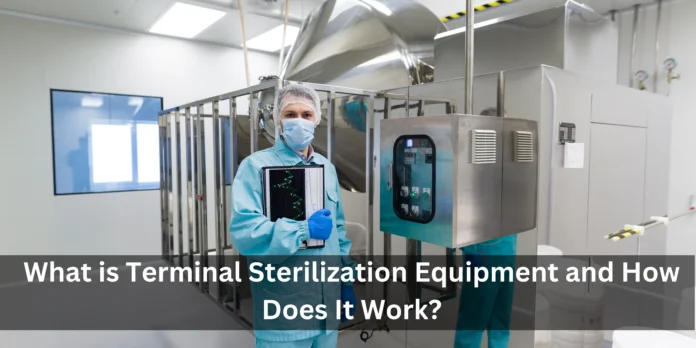Introduction
Terminal sterilization equipment plays a vital role in ensuring the safety and efficacy of various products in different industries. The process of terminal sterilization involves the elimination of all viable microorganisms, including bacteria, viruses, and spores, from a product or its packaging. This article will explore the significance of terminal sterilization equipment in diverse sectors and delve into its working mechanisms.
Understanding Terminal Sterilization
Terminal Sterilization Defined: Terminal sterilization is a method employed to achieve the complete eradication of microorganisms from a product or its packaging, thereby rendering it free from any microbial contamination. This is crucial in industries where products come into direct contact with consumers or patients, as it helps prevent infections and ensures product safety.
Common Industries Utilizing Terminal Sterilization Equipment: Terminal sterilization is widely used in healthcare, pharmaceuticals, food packaging, and other sectors where microbial control is essential. Medical devices, pharmaceutical drugs, and even certain food products undergo terminal sterilization to guarantee their safety and integrity.
Different Types of Terminal Sterilization Equipment
There are several types of terminal sterilization equipment available, each with its specific application and advantages:
- Autoclaves: Autoclaves are widely used in healthcare settings to sterilize medical equipment and devices. They use high-pressure steam to eliminate microorganisms effectively.
- Ethylene Oxide Sterilizers: Ethylene oxide is a gas commonly employed to sterilize heat-sensitive medical devices and pharmaceutical products.
- Gamma Irradiation: Gamma irradiation employs ionizing radiation to sterilize products. It is commonly used for items that cannot withstand high temperatures or moisture.
- Electron Beam Radiation: Electron beam radiation is another method used for terminal sterilization, particularly in the medical device industry.
How Terminal Sterilization Works
Autoclave Sterilization Process: Autoclaves use pressurized steam to achieve sterilization. The high temperature and moisture kill microorganisms effectively, making it a widely used method in healthcare settings.
Ethylene Oxide Sterilization Process: Ethylene oxide gas penetrates packaging materials and kills microorganisms, making it an ideal choice for sensitive products.
Gamma Irradiation Process: Gamma irradiation uses a controlled dose of ionizing radiation to break the DNA of microorganisms, rendering them unable to multiply and cause harm.
Electron Beam Radiation Process: Electron beam radiation works similarly to gamma irradiation but is more focused, making it suitable for precise sterilization.
Advantages of Terminal Sterilization Equipment
Effective Microbial Elimination: Terminal sterilization is highly effective in killing all types of microorganisms, providing a high level of confidence in product safety.
Versatility in Application: Different types of terminal sterilization equipment allow for versatility in sterilizing various products, regardless of their size and complexity.
Assurance of Product Safety: Terminal sterilization ensures that products are safe for use or consumption, reducing the risk of infections and contamination.
Limitations of Terminal Sterilization Equipment
Compatibility Issues: Some materials and products may not be compatible with certain sterilization methods, limiting their application.
Time-Consuming Process: Terminal sterilization can be time-consuming, impacting production timelines, especially for large batches of products.
Safety Precautions and Environmental Concerns: Some terminal sterilization methods involve the use of hazardous substances or radiation, necessitating strict safety measures and environmental considerations.
Applications of Terminal Sterilization Equipment
Medical Devices and Equipment: In the healthcare industry, terminal sterilization is crucial for ensuring the safety of medical devices and equipment used in various medical procedures.
Pharmaceuticals: Pharmaceuticals, especially those administered through injections or in sensitive environments, undergo terminal sterilization to maintain their efficacy and safety.
Food Packaging: Certain food products, especially those with extended shelf lives, are subjected to terminal sterilization to preserve their freshness and prevent spoilage.
Quality Assurance and Regulatory Compliance
Importance of Adherence to Regulations and Standards: Compliance with stringent regulations and standards is essential to ensure the effectiveness and safety of terminal sterilization processes.
Validation and Monitoring: Manufacturers must validate their sterilization processes and regularly monitor them to maintain consistency and efficiency.
Future Trends in Terminal Sterilization Equipment
Technological Advancements: Terminal sterilization equipment is expected to witness technological advancements, making the process more efficient and accurate.
Integration with Automation and AI: Automation and artificial intelligence integration may streamline terminal sterilization processes, further improving safety and productivity.
Conclusion
Terminal sterilization equipment plays a critical role in ensuring the safety and integrity of products across various industries. With advancements in technology and increased focus on quality assurance, terminal sterilization is set to become even more efficient and reliable. Embracing the best sterilization practices while complying with regulations will continue to be pivotal in safeguarding consumers and patients alike.
FAQs
- What is the difference between terminal sterilization and aseptic processing? Terminal sterilization involves the complete elimination of microorganisms from a product or its packaging, while aseptic processing aims to prevent contamination during the manufacturing process.
- Are there any risks associated with terminal sterilization? Terminal sterilization methods are generally safe when performed correctly. However, some methods may have associated risks, such as exposure to hazardous chemicals or radiation.
- Can all products be terminal sterilized? Not all products are suitable for terminal sterilization. Some materials may be sensitive to sterilization methods or may not be compatible with certain equipment.
- How do manufacturers validate the effectiveness of terminal sterilization? Manufacturers conduct validation studies to ensure that the sterilization process effectively kills microorganisms without compromising product quality.
- Is terminal sterilization a cost-effective method for small-scale producers? Terminal sterilization can be cost-effective for large-scale producers, but for small-scale producers, the initial investment in equipment and validation processes may be challenging. However, its importance in ensuring product safety cannot be overlooked.

